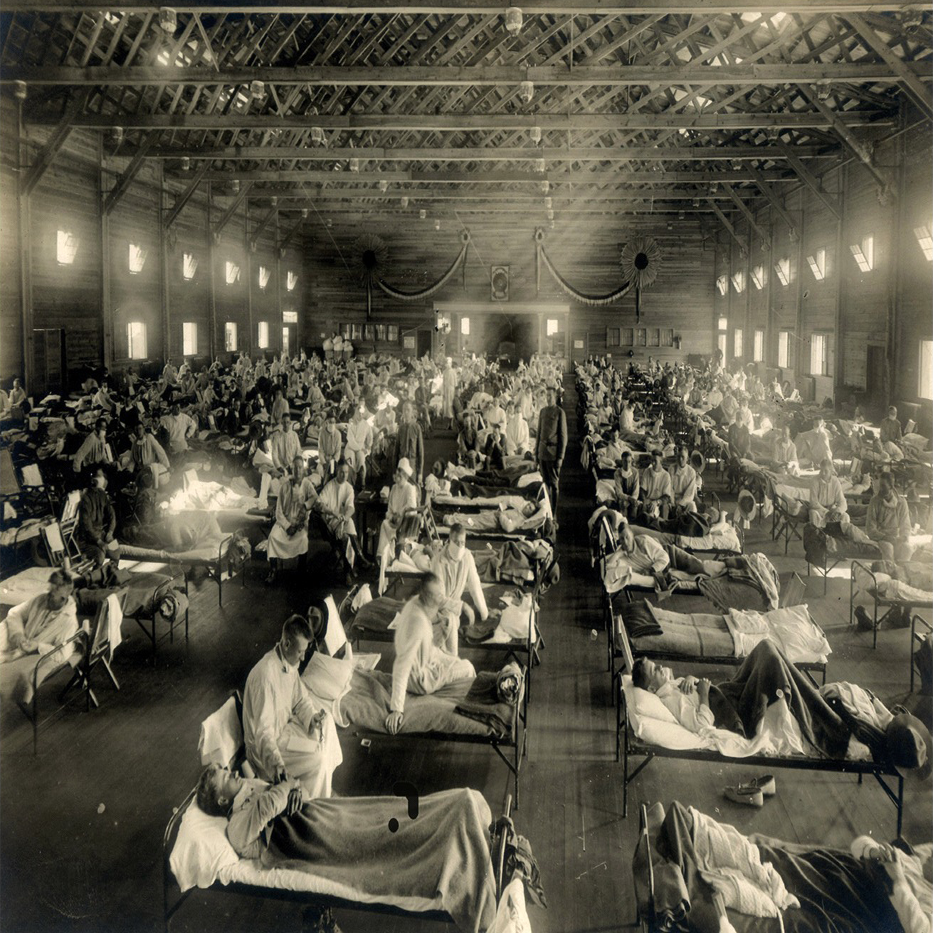
Chapter 1. Chapter 31: Immune System
1.1 Introduction

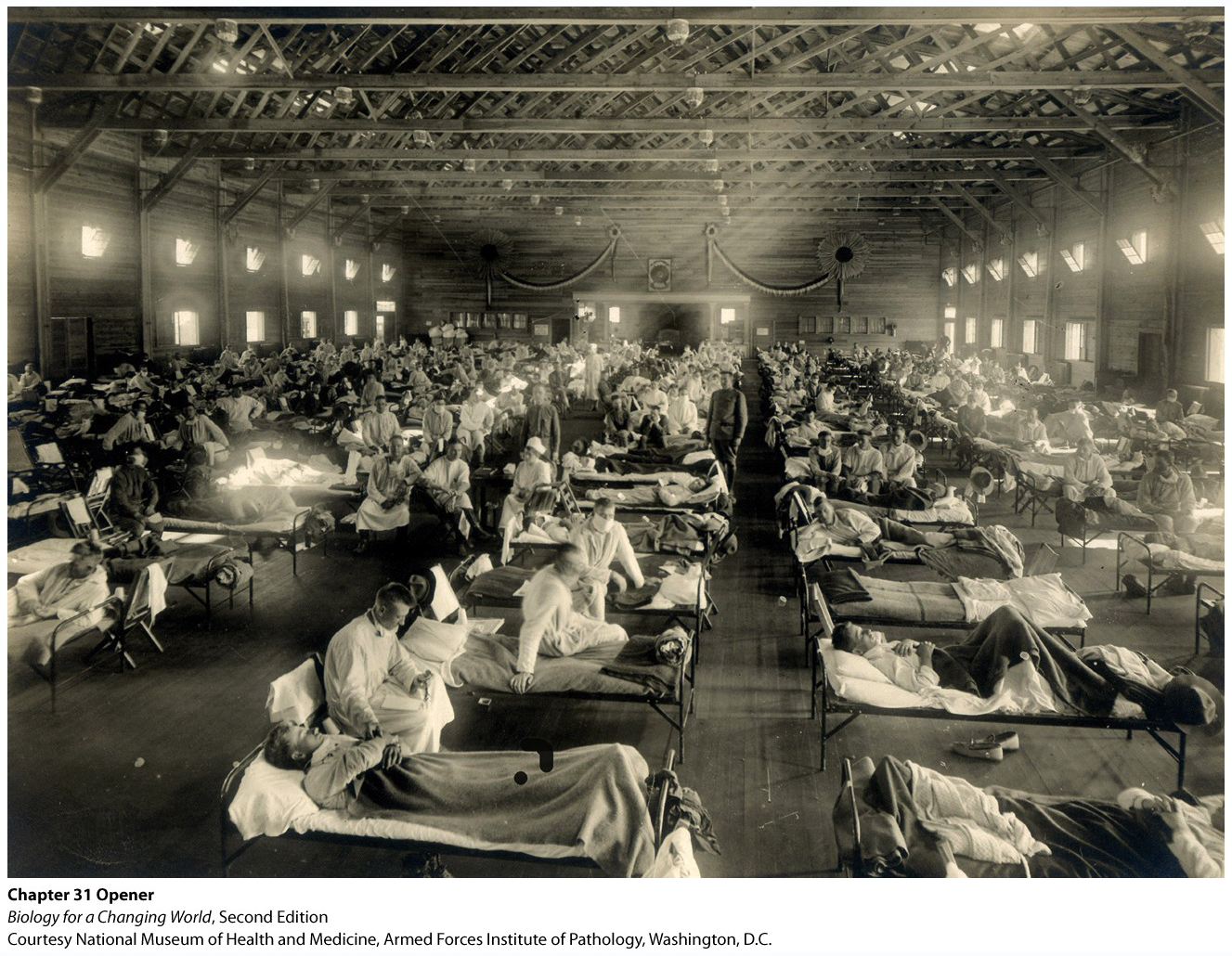
Welcome to the Interactive Study Guide for Chapter 31: Immune System! This Study Guide will help you master your understanding of the chapter's Driving Questions, using interactive Infographics and activities, as well as targeted assessment questions. Click "Next" to get started, or select a Driving Question from the drop-down menu to the right.
The Forgotten Plague:
After nearly a century, scientists learn what made the 1918 influenza virus so deadly.
DRIVING QUESTIONS
- What is the structure of a virus, and how do viruses cause disease?
- What is innate immunity?
- What is adaptive immunity, and how does vaccination rely on it?
- What specific features of influenza virus allow it to cause worldwide outbreaks?
1.2 Driving Question 1:
Driving Question 1
What is the structure of a virus, and how do viruses cause disease?
Why should you care?
Viruses cause diseases ranging in severity from the common cold to Ebola. Some, like the common cold virus, cause disease symptoms shortly after infection. Others, like HIV, can remain dormant for long periods before beginning to affect the host. With many viruses, recovery happens relatively quickly as the immune system gets rid of the invaders. Others, like the herpesvirus that causes cold sores or the varicella virus that causes chicken pox in children and the painful condition known as shingles in adults, cause latent infections: the virus is never eliminated but goes through periods of dormancy and activity for reasons that are not clearly understood. Viral diseases are difficult to treat; understanding how viruses infect and replicate in their host cells can help you understand why.
What should you know?
To fully answer this Driving Question, you should be able to:
- Diagram a typical virus.
- Diagram and describe the general process of viral infection and replication.
- Explain how replicating viruses can kill host cells.
Infographic Focus
The Infographics most pertinent to the Driving Question are 31.1 and 31.2.
Test Your Vocabulary
Choose the correct term for each of the following definitions:
| Term | Definition |
|---|---|
| Infectious agents, including certain viruses, bacteria, fungi, and parasites. Many pathogens trigger an immune response. | |
| An acellular infectious particle consisting of nucleic acid surrounded by a protein shell. | |
| A system of cells and tissues that acts to defend the body against foreign cells and infectious agents. |
Diagram a typical virus.
1.
In your notebook, diagram a virus, indicating its major components.
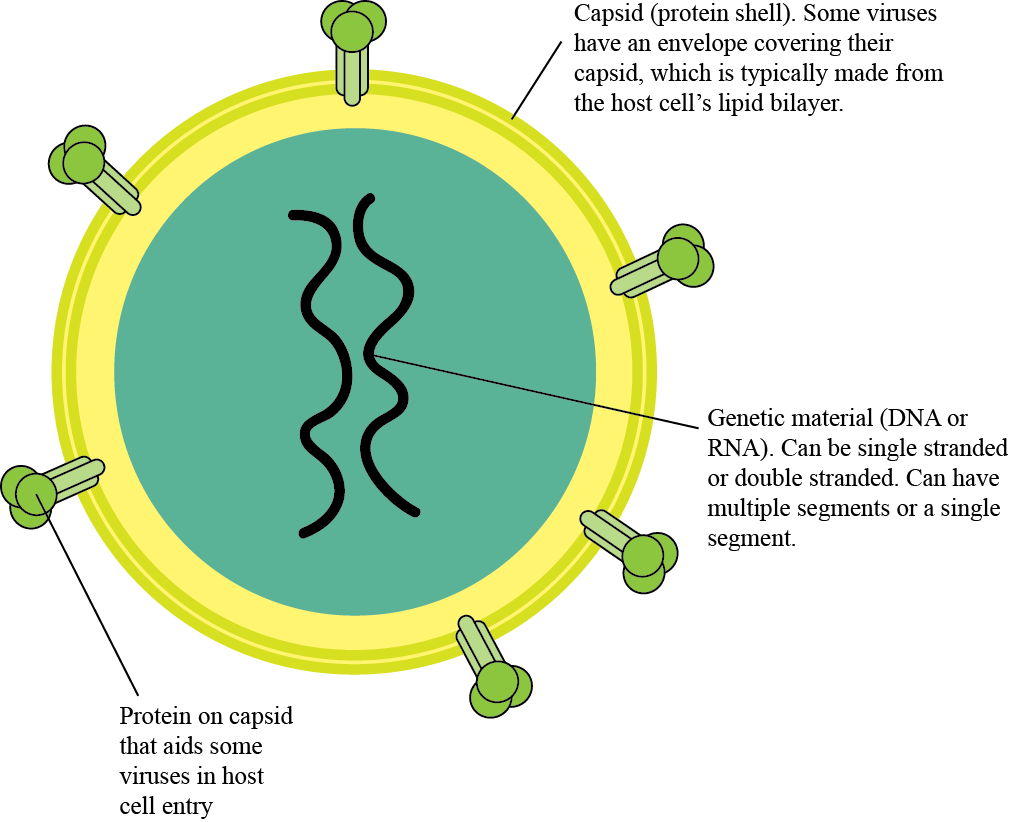
Diagram and describe the general process of viral infection and replication.
2.

Describe the process of viral infection and replication (in essay or list form) by incorporating each key process (numbered orange boxes) and structure (lettered orange arrows) into your answer.
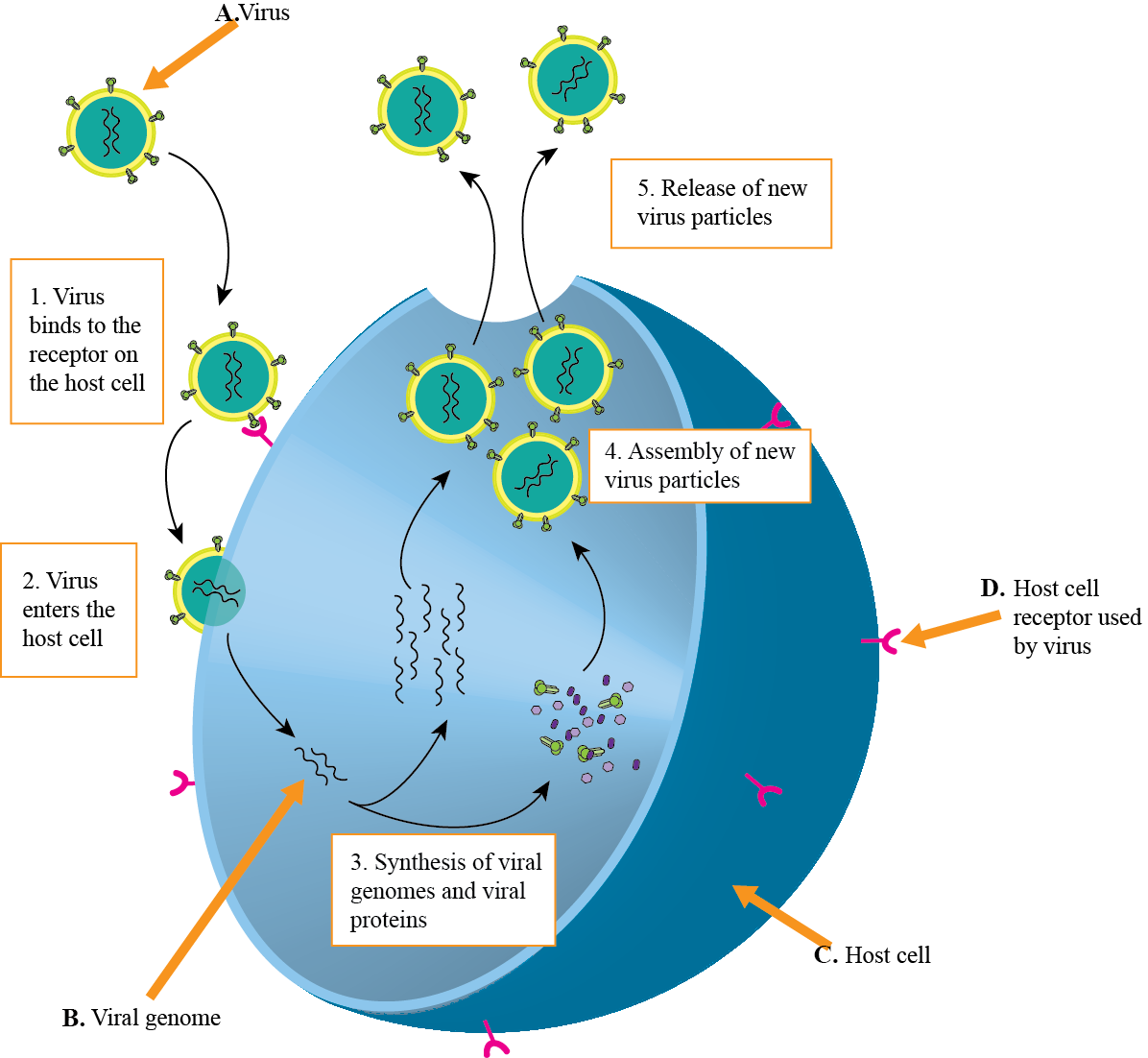
Explain how replicating viruses can kill host cells.
3.
List two ways in which replicating viruses can kill host cells. (Hint: Think about direct and indirect causes.)
Thought question: Why might it be advantageous for a virus NOT to kill the host organism?
Review Questions
4.
True or False: Viruses need host cells to reproduce.
| A. |
| B. |
5.
Choose the molecule(s) that may constitute a viral genome. (Mark "yes" all that apply)
| a. DNA | |
| b. RNA | |
| c. protein | |
| d. fatty acids |
6.
Which of these structures are found in viruses? (Mark "yes" all that apply)
| a. nucleus | |
| b. ribosome | |
| c. proteins | |
| d. DNA | |
| e. RNA | |
| f. endoplasmic reticulum |
1.3 Driving Question 2:
Driving Question 2
What is innate immunity?
Why should you care?
Most of us think of white blood cells and antibodies when we think of how we avoid infection, however, natural selection has led to a much more comprehensive defensive system, one that includes both rapid, nonspecific defenses (innate immunity) and slower but highly specific defenses (adaptive immunity). Between these two systems, a very large number of pathogens are defeated even before they make us ill; many more make us uncomfortable for a short time but do no long-term damage.
You know that exposure to pollen makes your eyes and nose runny. You know that mosquito bites and scratches leave red, hot, swollen marks on your skin. You know that your stomach fluid is acidic, and you may know that your saliva is as well. What you may not know is why. In fact, all of these are instances of your innate immune system protecting you from foreign invaders.
What should you know?
To fully answer this Driving Question, you should be able to:
- Describe the role of physical barriers in innate immunity.
- Describe the inflammatory process and its role in innate immunity.
- List the two types of phagocytes and describe their role in innate immunity.
- List three body fluids containing antimicrobial chemicals, explain the chemicals’ effect on pathogens, and describe their roles in innate immunity.
- Describe the role of complement proteins in innate immunity.
- Explain why each of these defense mechanisms is considered part of innate rather than adaptive immunity.
Infographic Focus
The Infographics most pertinent to the Driving Question are 31.3 and 31.4.
Test Your Vocabulary
Choose the correct term for each of the following definitions:
| Term | Definition |
|---|---|
| A type of white blood cell that engulfs and ingests damaged cells and pathogens. | |
| Nonspecific defenses, such as physical and chemical barriers and specialized white blood cells that are present from birth and require little or no time to become active. | |
| A type of white blood cell that acts during the innate immune response to find and destroy virally infected cells and tumor cells. | |
| The resistance to a given pathogen conferred by the activity of the immune system. | |
| Proteins in blood that help destroy pathogens by coating or puncturing them. | |
| An innate defense that is activated by infection or tissue damage; characterized by redness, heat, swelling, and pain. | |
| A phagocytic cell in the circulation that plays an important role in the inflammatory response. | |
| Antiviral proteins produced by virally infected cells that help protect adjacent cells from becoming infected. | |
| A molecule released by damaged tissue and during allergic reactions. | |
| A phagocytic cell that resides in tissues and plays an important role in the inflammatory response. |
Describe the role of physical barriers in innate immunity.
7.
List two major physical barriers in the body and describe how they contribute to defenses.
Describe the inflammatory process and its role in innate immunity.
8.
What are the two usual triggers of the inflammatory response?
9.
List and describe the steps of the inflammatory process in the correct sequence, assuming it is caused by an invading pathogen.
- Pathogen gets past physical barriers of defense.
- Tissues are damaged by invading pathogen.
- Damaged tissues release chemicals, such as histamine.
- These chemicals increase blood flow to the area and cause blood vessels to expand and leak fluid to surrounding tissues. They also attract white blood cells and clotting factors to the area.
- White blood cells engulf the pathogen, and the clotting factors contain the infection.
10.
What causes the redness, swelling, and heat associated with inflammation?
11.
What role does blood clotting play in the inflammatory process?
List the two types of phagocytes and describe their role in innate immunity.
12.
What are the two types of phagocytes associated with innate defense?
13.
What do these cells do?
14.
Why are these cells considered part of innate rather than adaptive immunity?
List three body fluids containing antimicrobial chemicals, explain the chemicals’ effect on pathogens, and describe their roles in innate immunity.
15.
List three body fluids containing antimicrobial chemicals, explain the chemicals’ effect on pathogens, and describe their roles in innate immunity.
Stomach acid kills many organisms ingested.
Tears break down bacterial cell walls, cause cell to burst.
These fluids have a barrier function in that they prevent pathogens from entering into the bloodstream or other internal body tissues.
Describe the role of complement proteins in innate immunity.
16.
How do complement proteins help us defend against pathogens?
Explain why each of the defense mechanisms described in these questions is considered part of innate rather than adaptive immunity.
17.
Explain why these defenses are considered part of innate rather than adaptive immunity.
Review Questions
18.
Which of the following is NOT a physical barrier of the innate immune system?
| A. |
| B. |
| C. |
19.
Natural killer cells kill pathogens through:
| A. |
| B. |
20.
Which of the following characteristics is NOT descriptive of the innate immune system?
| A. |
| B. |
| C. |
| D. |
1.4 Driving Question 3:
Driving Question 3
What is adaptive immunity, and how does vaccination rely on it?
Why should you care?
Many infectious agents have adaptations of their own that allow them to evade our innate defenses. You experience this every time you contract a cold, flu, or stomach virus. When our innate defenses fail, we rely on our adaptive immune system to destroy the pathogens that make us ill. Our adaptive immune systems do more than fight specific pathogens, though. They also remember those pathogens and prevent us from succumbing to them upon another exposure. The B and T lymphocytes are the key to adaptive immunity.
When pathogens invade, they can be present both inside individual cells and cruising around the tissues. Fortunately, natural selection has provided us with tools to deal with both scenarios. B cells produce special chemicals, called antibodies; these are our mobile defenses, able to detect and defeat mobile pathogens. A single B cell, having detected a pathogen, can multiply to produce an army of plasma cells, each of which may secrete up to 100 million antibodies per hour. Because of their specificity, antibodies are useful tools in diagnosing specific diseases and in many kinds of biological research.
Antibodies are great weapons against mobile pathogens. If pathogens have already invaded, though, we need another line of defense. Infected cells have mechanisms allowing them to signal that they’ve been invaded. Cytotoxic T cells recognize those signals and destroy infected body cells. Although this means that we lose some cells, it also means that we reduce the risk of many more cells becoming infected. Cytotoxic T cells are also a major target of research as possible anticancer agents: if they can be programmed to recognize specific markers of cancer cells, they can target and destroy those cells while leaving healthy cells intact. This would be a huge step forward in cancer treatment.
If you had chicken pox as a child, you know you are highly unlikely to contract it again. Your childhood vaccines provide long-term protection against diseases that are potentially fatal to children. People over age 65 accounted for the fewest cases of Spanish influenza; researchers believe that these individuals likely encountered a very similar virus earlier in their lives and had therefore developed partial immunity to the deadly strain. We owe long-term immunity to the secondary immune response, which takes advantage of the memory B and T cells that develop the first time we are exposed to a pathogen.
What should you know?
To fully answer this Driving Question, you should be able to:
- Identify the components of the lymphatic system and their functions.
- Define the origin and development of B and T cells.
- Describe the process that leads to the production of pathogen-specific antibodies.
- Explain what antibodies are and their role in fighting pathogens.
- Explain how our bodies develop immunological memory cells that can produce antibodies to an antigen they’ve encountered before.
- Describe the process that leads to the production of pathogen-specific cytotoxic T cells and how these cells fight pathogens.
- Explain the relationship between primary and secondary immune responses and the practice of vaccination.
Infographic Focus
The Infographics most pertinent to the Driving Question are 31.3, 31.6, and 31.7 to 31.9.
Test Your Vocabulary
Choose the correct term for each of the following definitions:
| Term | Definition |
|---|---|
| A protein produced by B cells that binds to antigens and either neutralizes them or flags other cells to destroy pathogens. | |
| White blood cells that mature in the bone marrow and produce antibodies during the adaptive immune response. | |
| A long-lived B or T cell that is produced during an immune response and that can remember the pathogen. | |
| The rapid and strong response mounted when a particular antigen is encountered by the immune system subsequent to the first encounter. | |
| White blood cells that mature in the thymus and that can destroy infected cells or stimulate B cells to produce antibodies, depending on the type of T cell. | |
| A type of T cell that destroys infected, cancerous, or foreign cells. | |
| A protective response, mediated by lymphocytes, that confers long-lasting immunity against specific pathogens. | |
| An activated B cell that divides rapidly and secretes an abundance of antibodies. | |
| A preparation of killed or weakened microorganisms or viruses that is administered to people or animals to generate an immune response. | |
| The organ in which T cells mature. | |
| A misdirected immune response in which the immune system attacks healthy cells. | |
| A type of T cell that helps activate B cells to produce antibodies. | |
| A specialized white blood cell of the immune system. Lymphocytes are important in adaptive immunity. | |
| A specific molecule (or part of a molecule) to which specific antibodies can bind and against which an adaptive response is mounted. | |
| A misdirected immune response against environmental substances such as dust, pollen, and foods that causes discomfort in the form of physical symptoms. | |
| The type of adaptive immunity that fights free-floating pathogens in the blood and lymph fluid. | |
| The type of adaptive immunity that rids the body of infected, cancerous, or foreign cells. | |
| The system of vessels and organs that works with the immune system, allowing B and T cells to respond to pathogens. | |
| Small organs in the lymphatic system where B and T cells may encounter pathogens. | |
| The adaptive response mounted the first time a particular antigen is encountered by the immune system. |
Identify the components of the lymphatic system and their functions.
21.
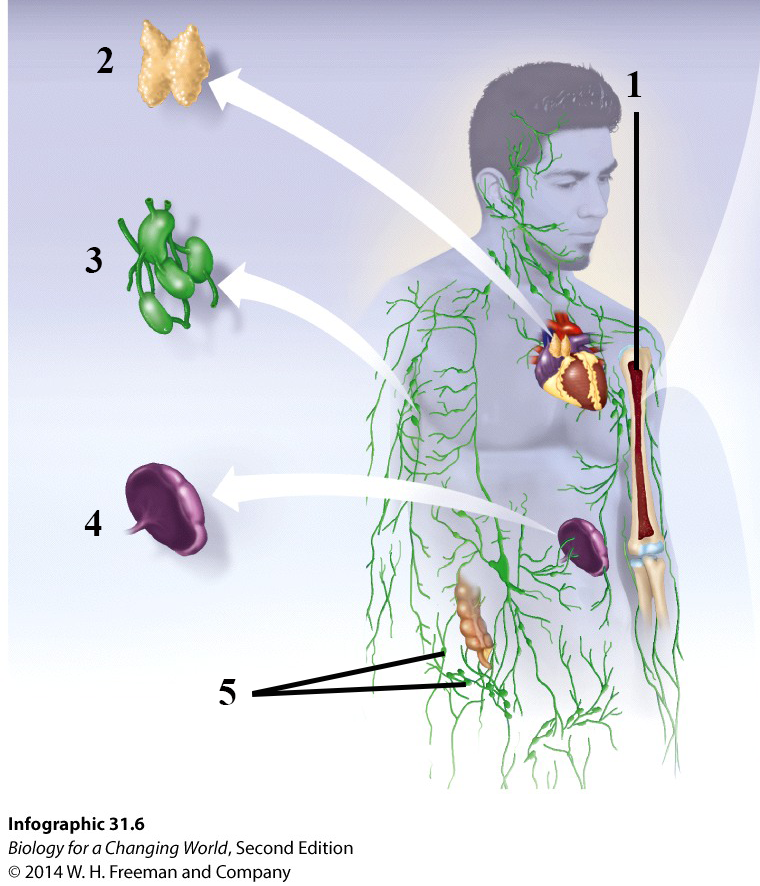
Correctly identify the indicated structures from Infographic 31.6 and briefly describe the function of each in the numbered spaces.
- Bone marrow: where immature white blood cells are produced
- Thymus: where immature lymphocytes migrate to mature into T cells
- Lymph nodes: where T and B cells respond to pathogens in the lymph fluid
- Spleen: where T and B cells respond to pathogens found in the blood
- Lymphatic vessels: where lymphatic fluid is drained from the tissues and so it can be passed through the lymph nodes on its way back to the tissues
Define the origin and development of B and T cells.
22.
Fill in the table.
| Type of Lymphocyte | Originates | Develops |
|---|---|---|
| B Cell | ||
| T Cell |
Describe the process that leads to the production of pathogen-specific antibodies.
23.
Which type of lymphocyte produces antibodies?
24.
Can this lymphocyte act alone, or does it need another type of lymphocyte to work with it? If the latter, what type of lymphocyte is involved?
25.
Describe the process by which the body can go from one single activated B lymphocyte and one single activated helper T cell to an army of plasma cells targeting a pathogen, beginning with the pathogen’s entry into the body.
- Pathogen enters the body and gets transported to the lymph node or spleen.
- A B cell recognizes as foreign an antigen on the surface of the pathogen.
- A helper T cell also recognizes as foreign an antigen on the surface of the pathogen.
- The helper T cell stimulates the B cell to divide and produce many plasma cells, all of which produce the same antibody directed against the invading pathogen.
Explain what antibodies are and their role in fighting pathogens.
26.
In your own words, describe what an antibody is and from what cell it is produced.
27.
List and describe three different ways antibodies help us fight pathogens.
Explain how our bodies develop immunological memory cells that can produce antibodies to an antigen they’ve encountered before.
28.
Where do antibody-producing memory cells come from?
Describe the process that leads to the production of pathogen-specific cytotoxic T cells and how these cells fight pathogens.
29.
What type of cell(s) activate pathogen-specific cytotoxic T cells?
30.
Describe the process by which our bodies can go from a single activated cytotoxic T cell to an army of lethal cells.
31.
Cytotoxic T cells are also known as killer T cells. Explain why by explaining how these cells fight pathogens.
32.
How does the body build memory cytotoxic T cells specific to pathogens already encountered?
Explain the relationship between primary and secondary immune responses and vaccination.
33.
What is considered the primary immune response?
34.
What is considered the secondary immune response?
35.
What are the different types of materials that may be used in a vaccine?
36.
After vaccination, which takes place, primary immune response, disease, or secondary immune response? Explain.
37.
How does a vaccination confer immunity against a pathogen?
Review Questions
38.
Which of the following lymphocytes is NOT part of the adaptive immune system?
| A. |
| B. |
| C. |
| D. |
39.
True or False: Antibodies can directly kill pathogens.
| A. |
| B. |
40.
Vaccination is a way to cause the immune system to undergo a:
| A. |
| B. |
41.
Memory cells allow for a ___________ action during ___________ immune response.
| A. |
| B. |
| C. |
| D. |
1.5 Driving Question 4:
Driving Question 4
What specific features of influenza virus allow it to cause worldwide outbreaks?
Why should you care?
You and/or your parents may remember the influenza pandemics of 1968 (the Hong Kong flu); you certainly should remember the H1N1 (swine flu) pandemic that began in 2009. Neither of these events was as severe as the Spanish influenza pandemic of 1918, but they serve as important reminders that influenza pandemics are unavoidable. That’s because influenza viruses change, both gradually via mutation and rapidly via gene swapping. Influenza researchers say that the question is not whether a new pandemic of severe influenza will occur, but when.
What should you know?
To fully answer this Driving Question, you should be able to:
- Compare and contrast the processes of antigenic drift and antigenic shift.
- Explain why antigenic shift is more likely to lead to new influenza pandemics than antigenic drift.
- Explain why public health officials monitor the types of influenza viruses infecting nonhuman animals as part of their surveillance against potentially human pandemic influenza strains.
Infographic Focus
The Infographics most pertinent to the Driving Question are 31.5 and 31.10, and Table 31.1.
Test Your Vocabulary
Choose the correct term for each of the following definitions:
| Term | Definition |
|---|---|
| Changes in antigens that occur when viruses exchange genetic material with other strains. | |
| Changes in viral antigens caused by genetic mutation during normal viral replication. |
Compare and contrast the processes of antigenic drift and antigenic shift.
42.
Complete the table to compare and contrast antigenic drift and antigenic shift.
| Do genetic changes happen quickly or slowly? | How do genetic changes occur? | Are genetic changes relatively small or relatively large? | Change in Surface Antigens | |
|---|---|---|---|---|
| Antigen drift |
Fill in: |
Fill in: |
Fill in: |
Fill in: |
| Antigen shift |
Fill in: |
Fill in: |
Fill in: |
Fill in: |
| Do genetic changes happen quickly or slowly? | How do genetic changes occur? | Are genetic changes relatively small or relatively large? | Change in Surface Antigens | |
|---|---|---|---|---|
| Antigen drift | Slowly | Through point mutations | Small | Slight |
| Antigen shift | Quickly | Through whole gene exchange | Large | Drastic |
43.
Summarize the similarities and differences you noted in one or two sentences.
Explain why antigenic shift is more likely to lead to new influenza pandemics than antigenic drift.
44.
Use the information you provided in the table to explain why antigenic shift is more likely than antigenic drift to lead to a new influenza pandemic.
Explain why public health officials monitor the types of influenza viruses infecting nonhuman animals as part of their surveillance against potentially human pandemic influenza strains.
45.
What role do animals such as birds and swine (pigs and their relatives) play in the development of new flu strains?
Review Questions
46.
Which kind of genetic change is caused as a result of the normal viral replication process?
| A. |
| B. |
47.
True or False: The flu vaccine offered every year protects against all strains of flu.
| A. |
| B. |
48.
What would be absent in a person infected with an influenza virus with novel genes from a bird influenza virus?
| A. |
| B. |
| C. |
| D. |
Activity results are being submitted...